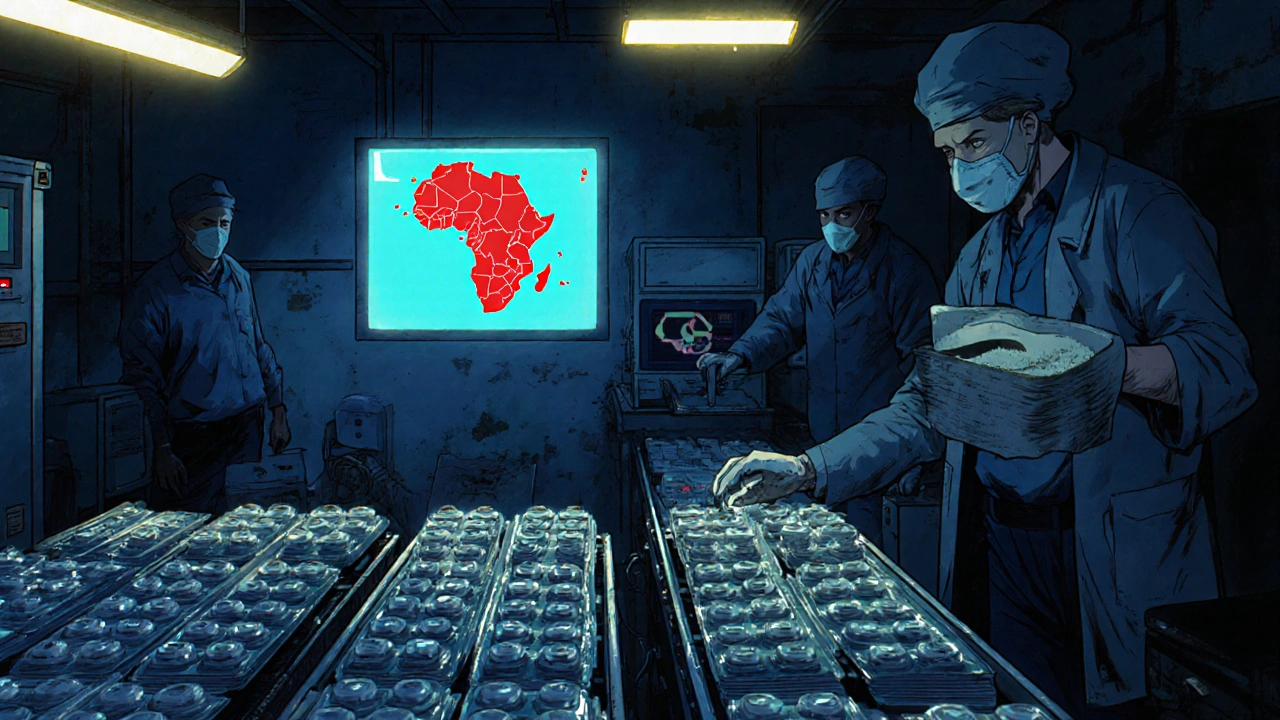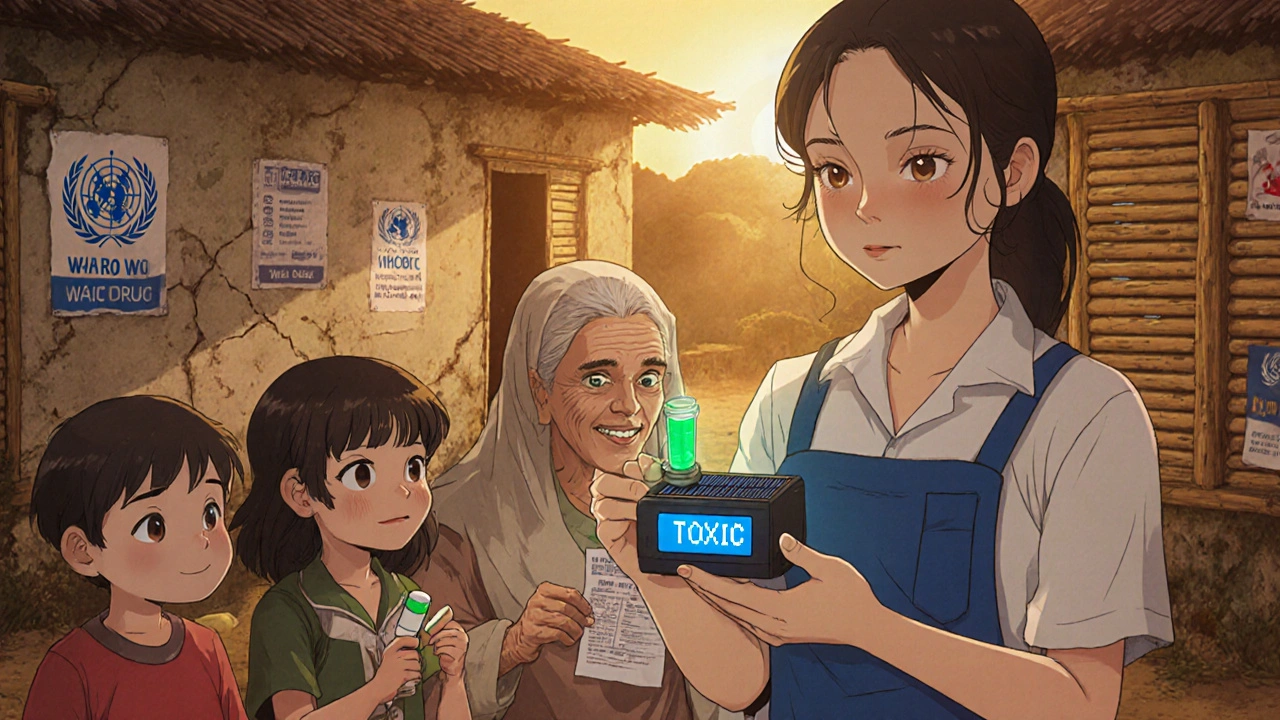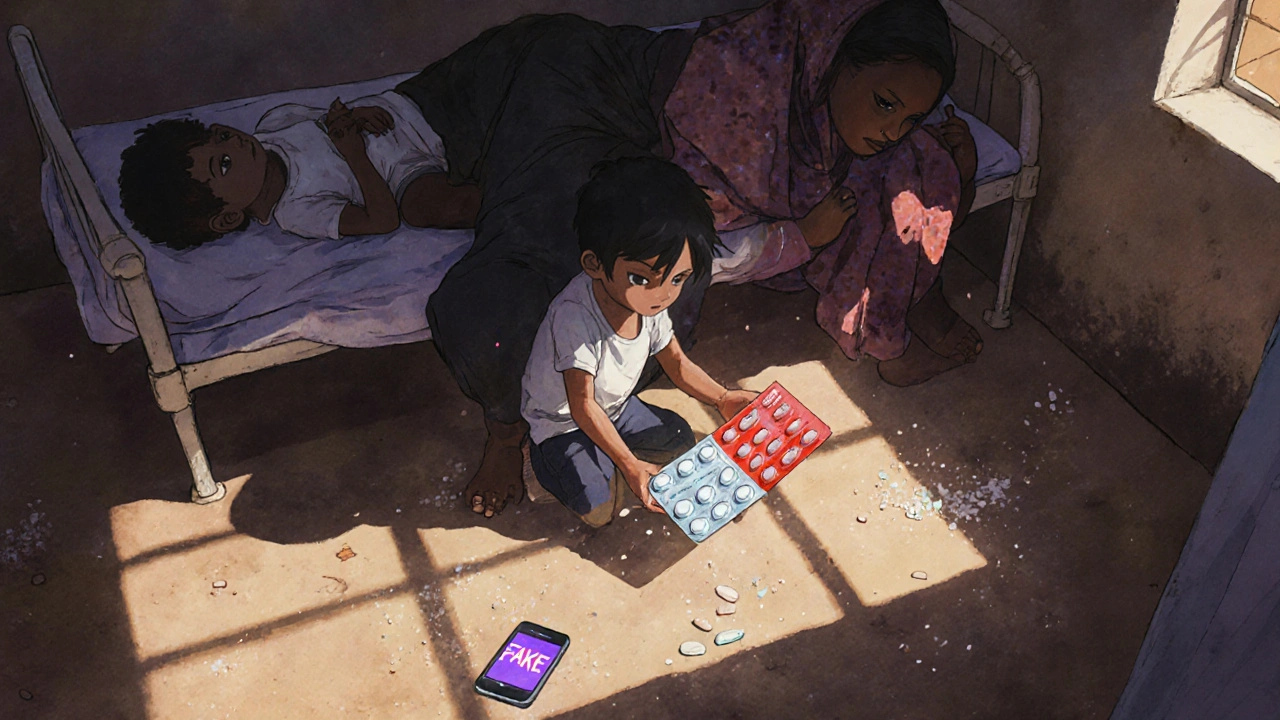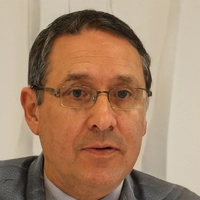Every year, more than 100,000 children die from pneumonia because the antibiotics they were given had no active ingredient. In rural clinics across Africa and Southeast Asia, patients take pills that look exactly like the real thing-same color, same logo, same blister pack-but they’re filled with chalk, talc, or worse, toxic chemicals. These aren’t mistakes. They’re crimes. And they’re happening at a scale most of the world refuses to acknowledge.
What Exactly Are Counterfeit Drugs?
Not all fake medicines are the same. The World Health Organization draws a clear line between two types: substandard and falsified. Substandard drugs are real products that were made poorly-maybe stored in a hot warehouse, expired, or diluted during transport. Falsified drugs are outright frauds. They’re made in secret labs, often in China or Bangladesh, with no oversight, no quality control, and no regard for human life.
Think of it this way: a real malaria pill might contain 250mg of artemether. A counterfeit version might have 5mg-or zero. A fake cancer drug might look identical to the real one, but instead of chemotherapy agents, it’s filled with flour and dye. In 2024, the Pharmaceutical Security Institute recorded over 6,400 incidents of counterfeit drugs across 136 countries. Nearly one in ten medicines in low-income nations is fake. In some border regions of Southeast Asia, it’s closer to half.
Why Is This Happening in Developing Nations?
The problem isn’t just about corruption or greed-it’s about broken systems. In many countries, there’s no strong medicine regulator. Pharmacies operate without licenses. Health workers get paid so little they can’t afford to refuse cash payments from unverified suppliers. And when the real drugs cost three to five times more than the fake ones, desperate families choose the cheaper option-even if they know the risk.
Take Nigeria, for example. A legitimate course of Coartem, the frontline malaria treatment, costs about $12. A counterfeit version sells for $1.50 at street markets. A mother with three children and no savings doesn’t choose between life and death-she chooses between feeding her kids and giving them medicine that might work.
Supply chains are another nightmare. Legitimate drugs travel through 5 to 7 middlemen before reaching a village clinic. Each stop is a chance for substitution. A shipment of antibiotics might be swapped for fakes in a warehouse in Lagos, then shipped again under a fake bill of lading. By the time it gets to a rural pharmacy, no one knows where it came from-and no one has the tools to check.
The Human Cost: Deaths, Resistance, and Suffering
The numbers are chilling. In sub-Saharan Africa alone, counterfeit antimalarials caused over 116,000 deaths in 2018. More recent data suggests that number has climbed. In 2022, a batch of fake cancer drugs circulated across multiple countries in West Africa. Patients who had already lost their hair and energy to chemotherapy were told they were getting the real treatment-only to find their tumors growing faster. One patient in Ghana told a WHO interviewer: “I thought the medicine was working because I didn’t feel worse. I didn’t know I was dying slower.”
Then there’s antimicrobial resistance. When antibiotics are weak or missing, bacteria survive. They adapt. They become stronger. A 2022 Lancet study found that 87% of counterfeit antibiotics in developing nations contained less than half the needed dose. That’s not just ineffective-it’s dangerous. It’s breeding superbugs that no drug can kill.
And it’s not just infectious diseases. Heart medications, diabetes pills, epilepsy treatments-all are being faked. In 2012, over 200 people in Lahore, Pakistan died after being given fake heart drugs contaminated with a toxic industrial chemical. The pharmacy had no way to test them. The hospital had no lab. The government had no system to track them.

How Are Fake Drugs Made to Look Real?
Counterfeiters aren’t amateurs. They use 3D printers to replicate blister packs with 99% accuracy. They copy holograms, barcodes, even the smell of the packaging. Interpol’s 2025 report found that 90% of fake medicines are indistinguishable from the real thing by sight alone. Even trained pharmacists can’t tell the difference without lab equipment.
Some fakes include real ingredients-but in the wrong amounts. Others have the correct dose but no shelf life. A pill might be perfectly made, but if it’s been sitting in a hot truck for six weeks, it breaks down. That’s substandard. But if the pill was never meant to have the active ingredient at all? That’s falsified. And it’s far more common.
The most dangerous fakes are those that mimic high-demand drugs: antivirals, insulin, chemotherapy agents. Criminals know where the money is. They don’t waste time making fake aspirin. They go for the life-or-death stuff.
What’s Being Done to Stop It?
Some solutions exist-but they’re not reaching the people who need them most.
Blockchain verification systems, like the one Pfizer uses, track every pill from factory to patient. Since 2004, Pfizer has blocked over 302 million counterfeit doses from reaching patients. But this system costs millions to set up. It requires internet access, smartphones, and trained staff-all things many rural clinics lack.
Then there’s mPedigree, a simple SMS-based system used in Ghana and Nigeria. You scratch off a code on the pill pack, text it to a number, and get a reply: “Authentic” or “Fake.” It’s cheap, works on basic phones, and has saved lives. One Ghanaian mother said, “I sent the code after my baby got sick. The reply said ‘fake.’ I threw the pills away. Two days later, the clinic gave us the real ones. He’s fine.”
But only 28% of users in low-literacy areas can use these systems without help. And only 22% of pharmacies in low-income countries use any kind of verification tool. In contrast, 98% of pharmacies in the U.S. and Europe do.
There’s also the Medicrime Convention, signed by 76 countries. But only 45 have turned it into national law. Without enforcement, it’s just a piece of paper.

Why Don’t Governments Do More?
Some governments are too weak. Others are too corrupt. In places where customs officials earn $100 a month, a $500 bribe to let a truck of fake drugs through is an easy choice. In countries where the health budget is already stretched thin, spending money on drug testing labs feels like a luxury.
Dr. Tedros Adhanom Ghebreyesus, WHO Director-General, says counterfeit drugs are “a symptom of weak health systems and a cause of their further weakening.” It’s a vicious cycle. Fake drugs kill people. People lose trust in the system. Fewer people go to clinics. Fewer clinics get funding. The system gets weaker. More fakes enter.
And then there’s the cost. The WHO estimates that developing nations spend $30.5 billion every year on fake or substandard medicines. That’s money that could build hospitals, train nurses, or vaccinate children. Instead, it’s gone-wasted on poison.
What Can Be Done? Real Solutions That Work
There’s no single fix. But here’s what’s working:
- Solar-powered testing kits-now used in 12 African countries-that can check drug quality in minutes without electricity.
- Community health worker training-in pilot areas, training local volunteers to spot fake packaging reduced counterfeit use by 37%.
- Mobile verification apps-like mPedigree-that work on basic phones and cost less than $0.01 per check.
- International pressure-the EU’s 2026 Anti-Counterfeiting Initiative will invest €250 million to help 30 developing nations build better drug safety systems.
These aren’t futuristic ideas. They’re already saving lives. The problem isn’t lack of knowledge. It’s lack of will.
What You Can Do
If you’re not in a developing nation, you might think this doesn’t affect you. But it does. Fake drugs fuel drug resistance. Drug resistance spreads. A superbug born in a village in India can be on a plane to New York in 12 hours.
Support organizations that fund medicine verification in poor countries. Advocate for global health funding. Don’t assume that “generic” means “safe.” Even legitimate generics can be substandard if they’re poorly made or mishandled.
And if you’re a traveler or expat in a developing country-don’t buy medicine from street vendors. Don’t trust unlicensed pharmacies. Ask for the batch number. Ask to see the verification code. If they don’t know what you’re talking about, walk away.
This isn’t just about medicine. It’s about dignity. About justice. About the right to live without being poisoned by the very thing meant to save you.
How common are counterfeit drugs in developing countries?
According to the World Health Organization, about 1 in 10 medicines in low- and middle-income countries are substandard or falsified. In some regions-like parts of Southeast Asia and sub-Saharan Africa-the rate can be as high as 30% to 50% for certain drugs like antimalarials and antibiotics.
Are counterfeit drugs only sold on the black market?
No. Many counterfeit drugs enter正规 pharmacies, clinics, and even public hospitals through corrupt supply chains. In some cases, fake medicines are distributed through government health programs because inspectors lack the tools or training to detect them. This makes them harder to avoid than people assume.
Can I tell if a drug is fake just by looking at it?
Almost never. Modern counterfeiters replicate packaging with 90% to 99% accuracy, including holograms, barcodes, and even the texture of the pill. Visual inspection alone has only a 30% success rate. You need lab tests or verification apps to be sure.
What’s the difference between substandard and falsified drugs?
Substandard drugs are authorized products that failed quality control-they may be expired, improperly stored, or diluted. Falsified drugs are illegal forgeries made with no regard for safety. They may contain no active ingredient, wrong ingredients, or toxic substances. Both are dangerous, but falsified drugs are intentionally deceptive.
Why don’t more people use verification apps like mPedigree?
Many people in rural areas lack smartphones, internet access, or literacy to use these apps. Even when they have the tools, they may not trust them or know how to interpret the results. Only 28% of users in low-literacy regions can use verification systems without help. Training and community support are critical.
Is buying medicine online safer in developing countries?
No. In fact, online pharmacies are one of the fastest-growing sources of counterfeit drugs. A 2024 Trustpilot survey found that 68% of negative reviews in Southeast Asia mentioned suspected fake medicines bought online. Many sites mimic real pharmacy logos and use fake customer reviews. Always verify through official channels.
What are the long-term consequences if this problem isn’t solved?
Without major intervention, the World Bank predicts counterfeit medicines could cause 5.7 million deaths in developing nations by 2030. Beyond deaths, drug resistance will make common infections untreatable, hospitals will be overwhelmed, and global health security will be at risk. The economic cost will also keep rising-current losses are $83 billion a year and growing at 12.3% annually.



14 Comments
Joe Durham
November 19, 2025 AT 06:14It’s insane how something this deadly is still ignored by so many. I used to think fake meds were a third-world problem, but then I read about how counterfeit insulin made its way into the U.S. through shady online pharmacies. This isn’t just about poverty-it’s about global negligence.
Every time we buy cheap generics without asking questions, we’re part of the problem. We need to demand transparency-not just in developing nations, but in our own supply chains too.
Derron Vanderpoel
November 19, 2025 AT 21:37ok so i just read this and im literally shaking. like. how is this not on the nightly news? my cousin works in a clinic in nigeria and she told me last year some kid died from ‘antibiotics’ that were just powdered sugar. they didn’t even have a microscope to test it. i’m not even mad. i’m just… heartbroken.
Timothy Reed
November 20, 2025 AT 23:25The systemic failure here is staggering. We have the tools-mPedigree, solar testing kits, blockchain tracking-but without political will and funding, they remain pilot programs. The WHO’s $30.5 billion annual loss figure isn’t just a statistic-it’s the cost of inaction.
International aid must prioritize infrastructure over charity. Training local health workers to verify drugs is more sustainable than shipping in foreign experts. This isn’t a humanitarian crisis-it’s a public health infrastructure crisis.
Christopher K
November 21, 2025 AT 20:40Oh wow. So now we’re blaming capitalism for people being poor enough to buy fake pills? Maybe if these countries stopped being corrupt dictatorships and started running their own damn health systems, they wouldn’t need us to fix their mess.
Meanwhile, I’m paying $800 for a prescription that works. Guess I’m just a sucker for quality.
Nick Lesieur
November 22, 2025 AT 23:26lol at the ‘community health worker training reduced fake use by 37%’-so what? 63% still got poisoned? That’s not a solution, that’s a Band-Aid on a hemorrhage.
And why are we even talking about ‘trust’? People don’t trust the system because the system is a lie. Stop pretending education will fix corruption. Burn it down and start over.
Angela Gutschwager
November 24, 2025 AT 14:58So… we’re supposed to just trust that mPedigree works? 😐
Also, why is everyone acting like this is new? It’s been happening since the 80s.
Andy Feltus
November 24, 2025 AT 20:22Here’s the uncomfortable truth: we don’t value life equally. If this were happening in a wealthy country, we’d shut down borders, arrest CEOs, and launch military strikes. But because it’s happening to people we don’t see, we call it ‘tragic’ and move on.
Counterfeit drugs aren’t a supply chain failure-they’re a moral failure. We’ve built a world where profit is sacred and human life is negotiable. Until we change that, no app, no blockchain, no ‘awareness campaign’ will matter.
Brian Rono
November 26, 2025 AT 10:47Let’s be real-this isn’t about ‘fake drugs.’ It’s about the West’s colonial hangover. We export our pharmaceutical patents, then act shocked when people can’t afford them. Then we lecture them for buying knockoffs.
Meanwhile, Big Pharma patents life-saving drugs for 20 years while people die waiting for generics. The real counterfeiters aren’t the ones in Bangladesh-they’re the ones in Zurich and New Jersey who patent cures and price them beyond reach.
seamus moginie
November 27, 2025 AT 18:42There’s a reason why mPedigree works in Ghana but not in rural Laos-infrastructure. You can’t text a code if your village has no signal. You can’t verify a pill if the nearest lab is 200km away on a dirt road.
Stop romanticizing tech fixes. What’s needed isn’t an app-it’s roads, electricity, and trained pharmacists who aren’t being paid in peanuts.
Dana Dolan
November 28, 2025 AT 10:14my aunt works at a clinic in the Philippines and she said they got a shipment of ‘antibiotics’ last year that turned out to be ground-up floor tiles. the kids kept vomiting. no one knew why until someone noticed the pills didn’t dissolve in water.
they just… kept giving them out. because they had no choice.
Zac Gray
November 29, 2025 AT 17:25Let’s not pretend this is just about ‘poor countries.’ The U.S. imported over $10 billion in pharmaceuticals from India in 2023. A lot of those are generics. How many of them were substandard? We don’t know. Because we don’t test.
And now we’re shocked when superbugs emerge? Surprise. We’re all connected. Your kid’s antibiotic-resistant ear infection? Could’ve started in a village in Bangladesh because someone couldn’t afford the real stuff.
Global health isn’t charity. It’s self-preservation. We’re all in this together-whether we like it or not.
Steve and Charlie Maidment
November 29, 2025 AT 17:41So we’re supposed to feel guilty because we’re not donating to mPedigree? I pay taxes. I vote. I buy organic. I recycle. I’ve done my part.
Meanwhile, the real problem is that people in these countries don’t have access to clean water, let alone proper medicine. Fix the basics first. Stop putting Band-Aids on a broken leg.
Michael Petesch
December 1, 2025 AT 13:59It’s fascinating how this mirrors historical patterns of colonial exploitation. The same supply chains that once extracted raw materials now distribute lethal fakes. The infrastructure was never built for local needs-it was built for extraction.
And now we’re surprised when the system collapses? We didn’t build resilience-we built dependency. The solution isn’t just tech-it’s sovereignty. Local manufacturing. Local regulation. Local ownership.
Ellen Calnan
December 2, 2025 AT 10:35I keep thinking about that Ghanaian mother who saved her child by texting a code.
Imagine if she’d had a smartphone. Imagine if she’d had internet. Imagine if she’d had a doctor who wasn’t overworked and underpaid.
But she didn’t. And yet-she still fought. She didn’t wait for a government. She didn’t wait for a billionaire. She used the one tool she had: a flip phone and a desperate hope.
That’s the real story here. Not the fakes. Not the corruption. Not the billions.
It’s the mother. Who, against all odds, still chose to check. To question. To protect.
And we’re the ones who let her need to do that in the first place.